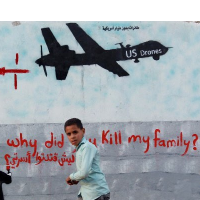Is U.S. Ignoring Obama’s Promise to Avoid Civilians Killings by Drones?
 (photo: Mohammed Huwais, AFP/Getty Images)
(photo: Mohammed Huwais, AFP/Getty Images)
“I believe that America is testing its lethal inventions in our poor villages, because [it] cannot afford to do so at any place where human life has value. Here, we are without value.”
-Moqbel Abdullah Ali al-Jarraah, of Silat al-Jarraah, Yemen, where a 2013 U.S. airstrike hit a civilian house
President Barack Obama claims that’s not true. “Before any strike is taken, there must be near-certainty that no civilians will be killed or injured—the highest standard we can set,” he said, also in 2013. But a report (pdf) written by the Open Society Justice Initiative, after it examined nine drone strikes in Yemen, shows the opposite. In those attacks, 26 civilians, including five children, were killed and 13 more wounded.
“We’ve found evidence that President Obama’s standard is not being met on the ground,” Amrit Singh, an Open Society senior legal officer and a primary author of the report, told The New York Times. “There’s a real question about whether the near-certainty standard is being applied in practice.”
Obama in April 2012 is said to have authorized “signature strikes” in Yemen by U.S. forces. In such attacks, targets are chosen based on behavior patterns, not on a specific identification of a target. It’s hard to see how those using this method could ensure that no civilians are hurt.
Even when missiles are targeting selected individuals, civilians get caught in the crossfire. In April 2014, two U.S. drones fired on an SUV. The occupants, who were members of al-Qaeda, were killed. But shrapnel from the missiles also hit laborers in a nearby pickup truck. Four of them were killed and another five wounded. Tribal leaders were compensated with $55,000 and 30 rifles, according to the Times.
The United States doesn’t discuss specifics of the drone attacks and only lately has admitted that they happen at all. But they’re no secret to residents of Yemen. “Every time an innocent civilian is killed or maimed by a U.S. drone strike or another targeted killing, it is felt by Yemenis across the country. These strikes often cause animosity towards the United States and create a backlash that undermines the national security goals of the United States,” Yemeni journalist Farea al-Muslimi told a subcommittee of the Senate Judiciary Committee.
“This program has no public disclosure about who’s being killed and why, and there’s no public accountability,” added Singh. “If you insulate a program with secrecy, you prevent information that could correct it from coming to light.”
The Obama administration has also said it will attempt to capture terrorism suspects “when feasible” rather than killing them with missiles. But in two of the incidents studied by Open Society, witnesses said the suspects could have easily been arrested by Yemeni authorities.
-Steve Straehley
To Learn More:
Death by Drone (Open Society Justice Initiative) (pdf)
Drone Strikes in Yemen Said to Set a Dangerous Precedent (by Scott Shane, New York Times)
Aiming for Two Militant Leaders in Pakistan, U.S. Drone Pilots Killed 233 People, including 89 Children (by Steve Straehley, AllGov)
Only 12% of Pakistanis Killed by Drones Identified as Militants (by Noel Brinkerhoff, AllGov)
- Top Stories
- Unusual News
- Where is the Money Going?
- Controversies
- U.S. and the World
- Appointments and Resignations
- Latest News
- Trump to Stop Deportations If…
- Trump Denounces World Series
- What If China Invaded the United States?
- Donald Trump Has a Mental Health Problem and It Has a Name
- Trump Goes on Renaming Frenzy






Comments